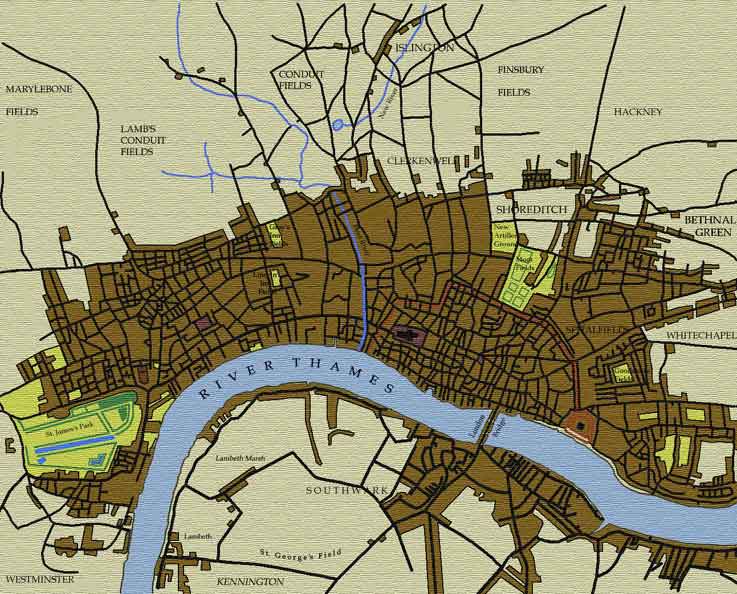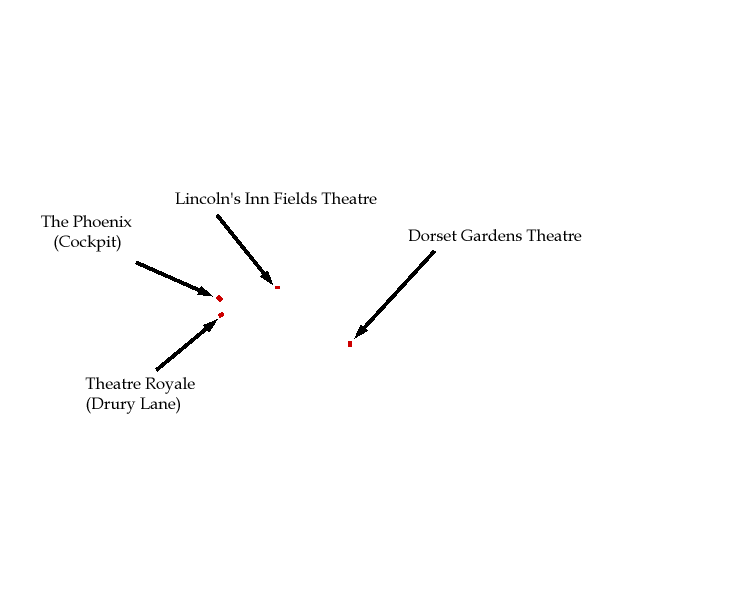


London ca. 1676
Restoration Theatres
|
With the Restoration in 1660, the London theatre scene, which had been discouraged if not actually suppressed during the Interregnum, became once again an important component of literary life in the capital. The new King was an enthusiastic patron of drama, and he – and many of his court – were eager to introduce onto English stages many of the innovations to which they had been exposed during exile on the Continent. There was little delay, then, in issuing two patents for new theatre companies, the Duke's Company and the King's Company, to Sir William Davenant and Thomas Killigrew respectively. |
|
Two important challenges faced the new patentees, however. Firstly, the old Jacobean theatres, closed down in 1642 and unused for nearly two decades, were in a state of terrible disrepair and no longer fit for use. Secondly, both patentees needed to find venues that would allow them to introduce the new Continental style of theatre, utilizing stages with proscenium arches, and set back deeply so that movable scenery and "flats" could produce spectacular three-dimensional effects. For practical purposes, then, Davenant and Killigrew were starting from scratch, and it was this that gave them opportunity to remake the London theatre. A vitally important decision was made early on: the theatres must be relocated from Southwark and the margins of the City, where they had largely been seated before the Civil War, to the growing Town in Westminster, which was the new seat of fashion. In choosing the area of Westminster between Whitehall, to the southwest, and the City, to the east, both patentees astutely made their productions convenient to Court, Town, and City. In recognition, too, of the new nature of the period's drama, and the importance of the beau monde as influential members of the audience, it was decided to keep the theatres small and intimate: the Restoration theatres held only about 500-800 people. These factors, in combination with the new stage designs and innovations in dramatic form itself, ensured that the theatre-going experience would, in 1660, be unlike anything London audiences had ever seen before. Cockpit Theatre Lincoln's Inn
Fields Theatre Royal
(Drury Lane) The Theatre Royal has, in its many incarnations, played an enormously important role in the history of English theatre; indeed, it has figured somewhat in English political history. It was here that an assassin attempted to kill the Prince of Wales (future George II) during a performance in 1716; coincidentally, an attempt was to be made on the life of this prince's grandson, now George III, in 1800, once again in the Theatre Royal. Wren's theatre was in active service for a full century, in a more or less unchanged state; it was redesigned and refaced in 1773 by Robert Adam, but this building was in turn demolished in 1791 to make way for a new and much larger theatre, capable of seating 3,611 people, designed by Henry Holland. This Theatre Royal was burned down in 1809, at which time a new theatre, which still stands today, was erected in its place. Dorset Garden
|
 |
Website maintained by: Mark
McDayter
Website administrator: Mark McDayter
Last updated: April 25, 2002